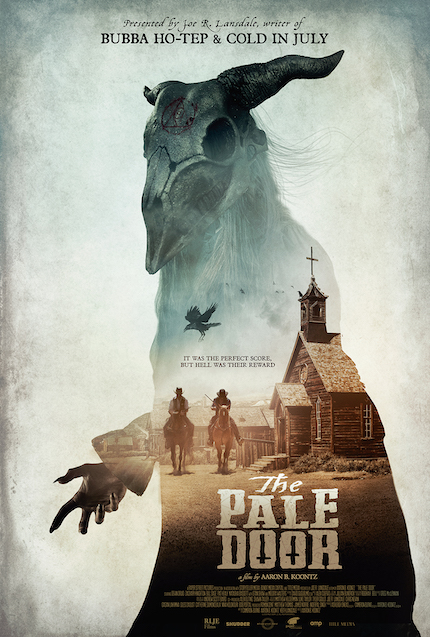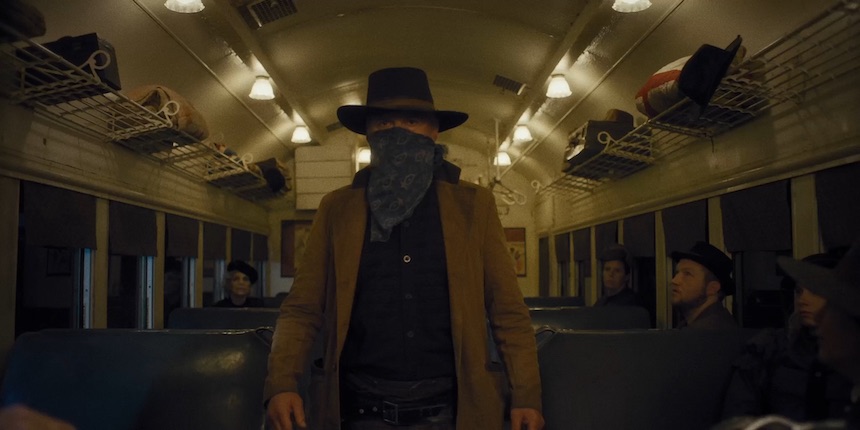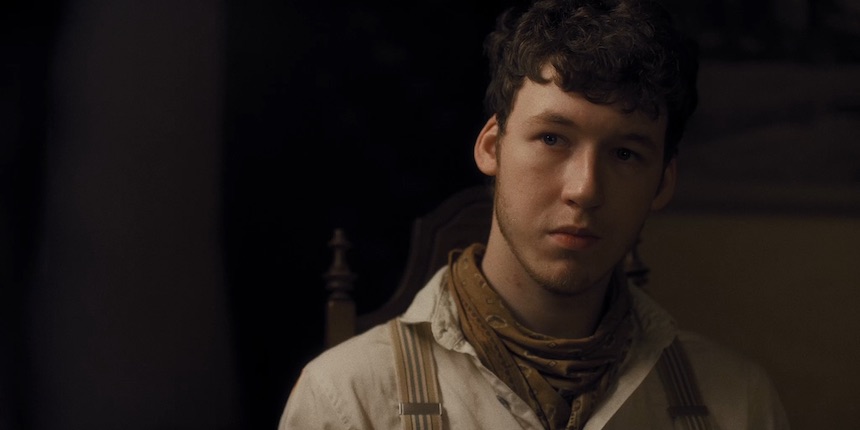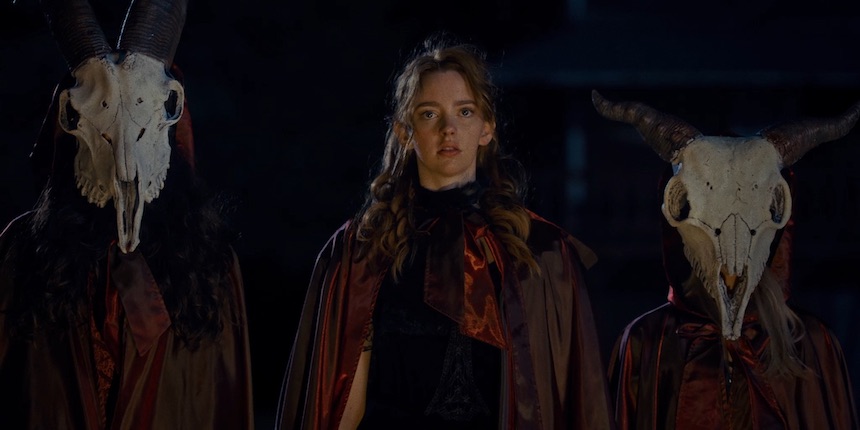THE PALE DOOR Interview: Director Aaron B. Koontz Talks Cowboys, Witches And Brotherhood

The Pale Door is the latest film that combines the western and the horror genre. In it, a gang of outlaws loses one of its members just before a robbery, then the leader Duncan’s (Zachary Knighton) clean younger brother Jake (Devin Druid) finally joins them.
Eventually, things get an unexpected turn when the trunk that the gang was supposed to rob from a train doesn’t contains material goods, rather they find a young girl (Natasha Bassett) chained inside.
After Duncan gets shot, the outlaws decide to seek for help in the girl’s hometown, thinking that they’ll kill two birds with one stone because the young lady promises them that a reward will be payed for her rescue.
Although there’s always a weird vibe, the gang is welcomed by the girl’s mother (Melora Walters) at the town’s brothel. But soon the fun turns into horror and violence, once the local women reveal their true identity and intention.
The Pale Door is now in theaters, On Demand and Digital. Before this release, I spoke with director and co-writer Aaron B. Koontz about his genre mashup.
ScreenAnarchy: I’m always into these mixtures of genres and horror and western are among my personal favorites. We’ve seen this particular mixture before but not that often, especially nowadays...
Aaron B. Koontz: Yeah, yeah, that’s part of what excited me, was just to do something that I hadn’t seen a lot before.
My writing partner Cameron Burns and I had been wanting to do like a really violent, gritty western, we had an idea for that but the script just didn’t really go where we wanted it to be, we kind of shelved it for a long time.
And then I was asked to pitch a witch movie and so I ended up pitching this, sort of “maybe I’ll take this original story, I like the characters in the western that we had written, but then maybe I can kind of usurp the second half of this and merge this witch story into this western.” It really got me excited about it. That pitch didn’t work out but it planted the seed of something I thought was really, really great. Then I was able to work with Joe and Keith Lansdale and get them on board and kind of make this happen.
And then the other element in this, I had also written another script with Cameron that we never fully finished but it was a really kind of cool idea that we thought, that dealt with the Salem witch trials, so I had done a ton of research about what had happened and the atrocities that had happened up there in Salem in the 1600s. It just fascinated me. I was like, well, these people weren’t witches but there was something interesting to me about the idea that what if the hate in this religious village that were persecuting these people, what if they and their hatred created the first witches, like the real witches out of that hate? I was like “that could be something that’s really interesting.” That just got us so excited.
Aside of the genre stuff, the humane aspect is very important to the story, that is the relationship between the brothers and their past. Even some important scenes are really just about members of the gang opening with the boy and acting like father figures for a way to say it. How important was to incorporate the humane background into a genre film?
It means so much that you said that and you talked about that because that’s what I wanted to do more than anything.
My brother is a recovering addict, my father is a person that as a kid I look up to a lot and it turned out he wasn’t the great person that I thought he was. So I wanted to write something about that story, it’s such a very personal story to me, it’s about two brothers, it’s about learning as you get older and you find a way where you forgive the people that you don’t want to forgive and you find a way to make your own path.
There’s a thing about how violence creates more violence and hate begets hate. We wanted just to parallel that both with how this gang got formed and then also with the witches and like seeing that they both came from a place where there were good people that were there and then they get kind of caught up.

But in the end, if the part with the brothers at the beginning, and there’s the scene with Lester (Stan Shaw) and Jake in the church, he’s telling the truth of his family, and then the ending; those three pieces, they have to work to make this movie work, ‘cause I didn’t want it to be nothing but just fun, cowboys and witches... and it is, we got fun with that, we got the big shootouts, we got the big effects in the core.
But you’re so right, the sentimentality is what I’m most proud of and what I’m so most excited for people to see ‘cause I think that’s what’ll surprise people; if you just watch the trailer you don’t really get that and I’m excited for people to see that. I really appreciate you bringing that up.
Another interesting aspect is that we see the classic western gang of outlaws, but this time it’s very diverse: there’s a black man, a woman, a Native American, a religious guy. Where did this idea come from?
Yeah, again, thank you, another great question ‘cause that was important to me.
I love westerns but all of them are kind of just a bunch of white guys in gangs, you know? When you do research and you actually look into it, the gangs were diverse, ‘cause usually all people were outlaws for a reason, things have happened in their lives where they’ve chosen this path.
And they’re willing [the gang in the film] to take whoever to make the gang the stronger unit and they become this new band of brothers because of this. There’s definitely a parallel to these two brothers but they’re all brothers and that’s what Dodd (Bill Sage) says at the end, like “you weren’t the only one losing a brother right now.”
I wanted it to be even more diverse, actually at one point we were working with Clifton Collins as well. I actually wanted to bring in a Mexican member of the gang too but then he had to pull off at the last minute so we had to recast.
But yeah, I’m really proud of that and again, there were women in a gang, there were former slaves who became members of a gang as well, so once I saw that I was like “it could really help set us apart and kind of modernize this for the 21st century and just kind of show that there’s this diversity and there’s no reason I’ll be affected by the old rules of what those old movies used to be ‘cause that’s not how it really was back then.”

Can you comment more on the decision of exploring the “witches” of Salem?
When I was writing the other movie that was kind of about the Salem witch trials, I learned a lot about Cotton Mather and the man who like literally wrote the book on how to hunt these witches.
I read a story, and I don’t if it was true or not, but I read a story about a woman who escaped Salem. Most of the women of this time that were persecuted, they were actually chained or stoned, and it’s awful. They weren’t actually burned but there were some people overseas in Europe that were burned. And then there was this one story of a woman who was pregnant and she was being accused of being a witch and she fled the town, somebody tracked her down in another town and all she wanted to do was buy enough time to give birth to her child. They found her in the town and they strung her to a post and they burned her, pregnant. It was so horrific and so awful that I couldn’t get what kind of sick bigotry and ignorance caused something like that.
Then I thought about the themes of that and I was like “what if, if these people are witches, what if there was someone in the crowd who watched that, who was her friend, who maybe dabbled a little bit into witchcraft herself? And then the hate and the violence of that inadvertently created the actual witches. And like what would they do?.” I thought that was really fascinating.
Then it also allowed me to kind of play with what I wanted my witches to look like and the makeup effects. To have the long noses and ears and the wrinkly skin but as if they were burned to the stake and have their skin taking off. I’ve never seen anything like that and I wanted to be able to tell like a new version of witches.
Especially during that shoutout sequence at the brothel it’s, like you said, cowboys vs. witches. I love the fact that it’s graphic, crazy and violent, like there’s nothing mysterious anymore about who these women are at that point. How was the conception of this very important and I guess challenging sequence?
It was the biggest thing I’ve ever shot in my life [laughs]. We were doing wirework, each of the witches took over four hours to do the makeup, we were doing stunts and wirework throwing people off balconies and breaking stuff, breaking the doors, all the makeup effects. We had to shoot that whole sequence in two days; if anyone knows anything about shooting action sequences like that, a Hollywood movie, a bigger movie would’ve had three weeks to shoot it. So it was a lot to do, I’m really proud of what we were able to pull off.
The town that we shot in, I’ve traveled up there a few times and my director of photography Andrew Baird and my producer and partner in writing Cameron Burns, we went up there with iPhones and iPads and we like kind of storyboarded the whole thing; there’s a video that nobody will ever see but it’s me and Cameron, I put Cameron to be the cowboys and the witches in like every shot. That allowed us to kind of pre-visualize how this could work and show it to our stunt coordinator, to the team, and we planned that out meticulously for as long as we could. It was a massive undertaking to kind of get done, yeah.

After that violent, crazy sequence, the film goes into a different direction. It’s more atmospheric, confusing, creepy. It’s still graphic but feels more closer to physiological horror. Where that decision came from?
Part of that was, I loved playing with the origin of these witches and the kind of folklore that existed. And what I learned was, they do a lot with like the familiars, with like the use of animals so the crows and the wolves.
But then also they like to play with the psychological warfare and we wanted to build a world where these witches were having fun with them. I liked this idea of kind of playing with their heads and the psychological warfare that I had read about that had happened in what they did.
And then getting into that church, with that big set piece, they can’t enter it and they can’t physically touch them in the church at that moment, how would they find a way to still mess with them from outside of that? That just became a fun thing to explore.
More than having a classic western duel like those of Sergio Leone, for instance, the climax is more about the theme of sacrifice. Why did you decide to go for a more thematic kind of climax? And also, I think the ending leaves the door open for different interpretations...
Yeah, again, another wonderful, thoughtful question, because originally we did have a big, kind of battle sequence and all this, and it became something that was there. And then in talking with Keith and Joe Lansdale and the team, I was like “it needs to be about the brothers.” So we kind of repurposed it, to kind of come up with a more subdued thing. Once that happened, emotionally the movie was there, that’s what was needed.
But then yeah, you still want to alude to there’s more and it could be more that’s going on and it could innocuous or could be something more sinister, and I like leaving the door open for your interpretation of what that could be.
The core of the story is about two brothers and the journey of sacrifice and learning how to let go all the hate and to move on and to become the person that you can become and to let off the shackles of previous problems, persecution, hate and frustrations, in order to try and become a better person. These brothers are sacrificing each other for each other.







